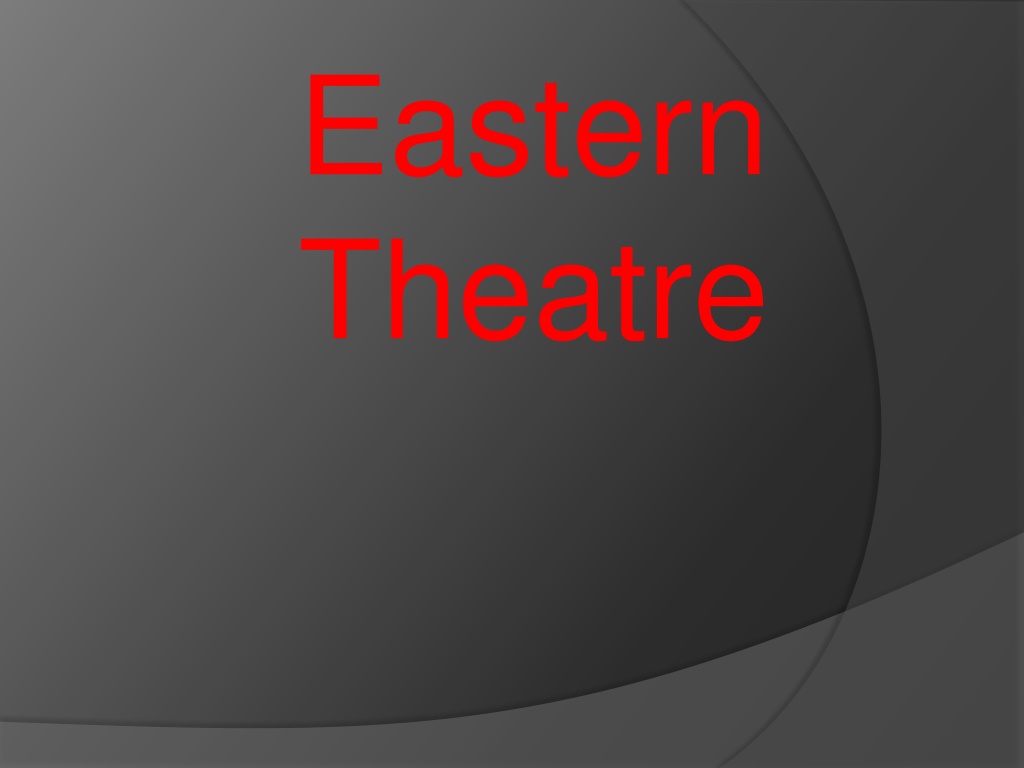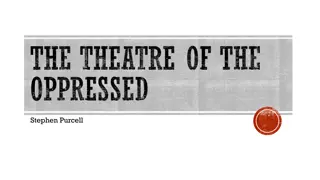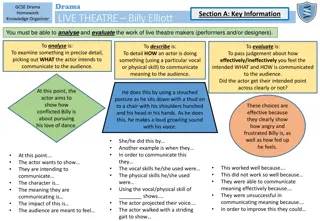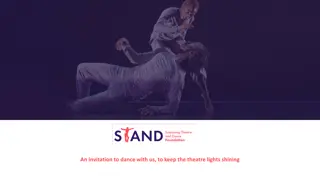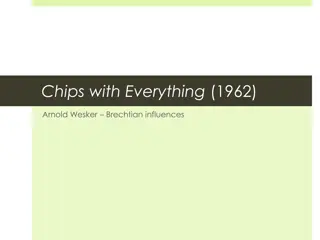The Vibrant World of Eastern Theatre
Explore the captivating world of Eastern theatre, encompassing the alluring sounds and colors that define its essence. From the ancient Noh performances deeply rooted in religion and tradition to the intricate art of Bunraku puppetry and the influential Kabuki plays, Eastern theatre offers a rich tapestry of storytelling through expressive masks, larger-than-life costumes, and rhythmic beats. Each form, be it Noh, Bunraku, or Kabuki, presents a unique blend of acting, dance, music, and intricate movements that have stood the test of time, captivating audiences with their cultural richness and artistry.
Uploaded on Sep 10, 2024 | 0 Views
Download Presentation

Please find below an Image/Link to download the presentation.
The content on the website is provided AS IS for your information and personal use only. It may not be sold, licensed, or shared on other websites without obtaining consent from the author. Download presentation by click this link. If you encounter any issues during the download, it is possible that the publisher has removed the file from their server.
E N D
Presentation Transcript
Eastern Theatre
Eastern Theatre One of the immediately visible appeals of any form of theatre is the lure of the sound and the color Easter theatre seems to have perfected this Larger than life costumes Expressive masks Life-like puppets Contagious, rhythmic beat
NOH Pronounced no Oldest form of Eastern theatre Deeply rooted in religion and ceremony Combination of acting, dance and music, rhythmically entwined in a strict form that was passed to each generation in rigid training Training starts in childhood Short plots generally deal with myths and legends Stock characters symbolized on-stage by masks Each Noh also has a kyogen (a comic interlude) Like the Greek satyr play Performance combined gliding movements, chanting and stomping in unison with a flute and drum accompaniment Strength of performance is the fluid beauty of the combined movement, sound and speech.
Bunraku Form of Japanese theatre Uses intricately hinged wooden puppets Puppets stand four feet tall and have moving fingers and facial expressions Three puppeteers for each figure Puppeteers are masked in all black but are visible to the audience Once the story begins they seem to disappear This form originated in Korea but migrated to Japan in the sixth century AD
Kabuki Most influential of Asian theatre Employs singing, dancing, and acting ka=singing, bu=dancing, ki=acting Originally produced by women Newest of the three Eastern forms was an imitation of Noh and the Bunraku Plots based on historical tales or stories about everyday life Kabuki actors do not wear masks Characterized by dramatic face paint Stylized movement Elaborate costumes Today only men act in the plays They spend most of their lives studying their art, starting as children and are loyal actors until they die.
Kabuki Stage Raised wooden platform Because of rhythmic stomping is such a prevalent part of the style, amplifying wooden sections are often laid on top of the stage The hanamichi (flower path) is a raised passageway that extends from one corner of the stage through the audience
Kabuki Stage cont. Like Greeks, Kabuki audience will hear narration and dialog from a chorus of twelve to eighteen members The chorus members are uniformly dressed and carry a fan This adds to the beauty of the performance The orchestra sits at the back of the stage Drums A flute Stringed instrument (samisen) They are dressed like the chorus
Kimono Traditional, floor-length robe with draping sleeves Worn by both male and female characters Distinguished by a variance in color, fabric, or accessories
Kabuki performance Stylized wigs are worn to add size and color Unrealistic make up is painted with brightly colored, sharply contrasting lines meant to show expression The actors do not try to achieve realism. Kabuki is fantasy storytelling Actor s movements look more like dancing than acting Props are brought on stage by crew members dressed in all black Speeches are told with rhythmic musical accompaniment May be told by several actors in unison or speaking in turn. Very ceremonial theatre
China Peking Opera Harmonious blend of song, dance, dialog, and acrobatics Subjects of the operas come from fiction, legend, and history Superb costumes serve to enhance the performance Color is used to indicate rank and temperament Originally acted by men, women were later introduced to the Chinese stage Unfortunately, after the establishment of the People s Republic in 1949, new plays were saturated with military propaganda Some new playwrights occasionally surface, and when they do, the entire world has reason to celebrate.
